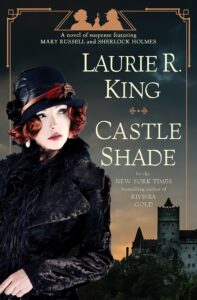You know Dracula, right? The book that spawned an entire industry of knickknacks, tourist attractions, bad jokes, films (almost as many as Sherlock Holmes), and pastiches? Do you ever wonder if anyone asked Bram Stoker that most basic of questions aimed at writers, namely, Where do you get your ideas?
The truth is, writers don’t always know for sure. Writers have magpie minds, always picking up shiny or odd-shaped bits—a castle, a historical figure, an interesting tidbit of folklore—and seeing how they might fit together. Sometimes it takes a little detective work to find the original elements of an elaborate structure.
In 1849, Emily Gerard was born to a well-off, well-known Scottish family. They traveled a lot, living in Vienna for a time, where Emily studied languages at a convent school. She married a Polish cavalry officer twenty years her senior, and followed her husband to his posts in Eastern Europe.
When she was in her thirties, mother of two young sons, her husband took up a position in the far corner of Transylvania. Gerard was a writer by this time, having published stories, reviews, and a few novels in collaboration with her sister, so her imagination was roused by this fascinating and utterly unknown part of the world. Apparently fearless—“Nonsense!” she says, when her young son urges her to take her revolver on a solitary trek—and fluent in several languages, she would merrily set off on an “easy” walk (“not more than two hours off”) to a spot on a map far from any road, or to a ragged tent she’d spotted on waste-land. There she would watch, and listen, and ask all manner of questions about the work, beliefs, rituals, and lives of the residents.
From these experiences, Gerard wrote an essay on “Transylvanian Superstitions,” which was accepted for publication in one of Britain’s most widely respected journals. The Nineteenth Century was a monthly literary journal read by the intellectual community and carried in all important libraries. But Gerard was also working on a book.
The Land Beyond the Forest, published in 1888, shows a young Victorian woman striding off or mounting up to ride into remote villages, poking her nose into the habits of peasants and shopkeepers, and listening to their stories—a sort of Transylvanian Margaret Mead, without the Masters degree. Because this is what an anthropologist does: go to a new place, talk to everyone, keep notes, and try to make sense of it all. Naturally, Gerard did not have the advantage of an established academic discipline to teach her what questions to ask and how to compare them. (Although even Mead’s academic rigor, we now realize, was less than scrupulous.) But in both essay and book, Emily Gerard’s exploration of Transylvanian culture is never less than lively, detailed, and personal, whether she is attending a wedding or discussing weaving patterns.
It is when she comes to the darker sides of Transylvanian folklore that Gerard steps into the edges of literary fame. In “Transylvanian Superstitions,” she describes peasant beliefs about what happens after death, and what happens when the dead apparently don’t stay dead:
These restless spirits, called Strigoi, are not malicious, but their appearance bodes no good, and may be regarded as omens of sickness or misfortune.
More decidedly evil, however, is the vampire, or nosferatu, in whom every Romanian peasant believes as firmly as he does in heaven or hell. There are two sorts of vampires—living and dead…..
Every person killed by a nosferatu becomes likewise a vampire after death, and will continue to suck the blood of other innocent people till the spirit has been exorcised, either by opening the grave of the person suspected and driving a stake through the corpse, or firing a pistol shot into the coffin. In very obstinate cases it is further recommended to cut off the head and replace it in the coffin with the mouth filled with garlic, or to extract the heart and burn it, strewing the ashes over the grave.
The Land Beyond the Forest is a wide-ranging travelogue, interested less in scenery and architecture than in the nature of the people and the area’s historical and political significance. Both book and essay were taken seriously, and were found in most large British libraries.
About the time Emily Gerard first arrived in Transylvania, an Irish writer named Bram Stoker moved to London, to become manager of the Lyceum Theater. He moved among all the prominent writers and actors of his day, but he also took annual month-long holiday trips home, to give himself time to write.
In 1895, he began to poke around the edges of a new book. A spooky book, set in…Germany? No—farther East, the edges of the Austro-Hungarian empire. Transylvania.
Why choose that place? He’d never been there. So how did this writer’s magpie-mind pick up that setting among others?
Stoker was a member of the London Library from 1890-1897. A few years ago, one of their clever and patient librarians (a tautology, I know) made a close study of the notes Stoker made while writing Dracula, comparing them to the books known to be on the London Library’s shelves during the seven years of Stoker’s membership. Pulling down those actual volumes, he found annotations precisely corresponding to passages that Stoker had written down. (And yes, I’m afraid Stoker was the kind of monster who wrote in and dog-eared library books.)
Among the works with notes and check-marks at key places were Gerard’s essay in The Nineteenth Century, and her book The Land Beyond the Forest.
Stoker does not use Gerard’s term strigoi, seen above in her passage about vampires—but then, he is not talking about “restless spirits” as much as he is creating a specific individual. And it is interesting to compare portions of Dracula with that and other passages in Gerard’s work. For example, the one where Professor Van Helsing says to the victim’s fiancé, Arthur Holmwood:
“… all that die from the preying of the Un-Dead becomes themselves Un-Dead, and prey on their kind. And so the circle goes on ever widening, like as the ripples from a stone thrown in the water. Friend Arthur, if you had met that kiss which you know of before poor Lucy die; or again, last night when you open your arms to her, you would in time, when you had died, have become nosferatu, as they call it in Eastern Europe, and would for all time make more of those Un-Deads that so have fill us with horror.”
Or:
“I shall cut off her head and fill her mouth with garlic, and I shall drive a stake through her body.”
Or:
“Take the papers that are with this, the diaries of Harker and the rest, and read them, and then find this great Un-Dead, and cut off his head and burn his heart or drive a stake through it, so that the world may rest from him.”
Like any writer, Bram Stoker’s magpie mind collected shiny baubles from all over, not just one little-known Scotswoman who wrote tales of darkly exotic places. A friend regaled him with stories of the Carpathian Mountains. Research led him to a bloody Wallachian leader known as “Dracula,” who impaled his enemies on stakes, leaving them drained of blood. The holiday hotel where he went to write had an evocative castle nearby—one which, incidentally, bears no resemblance to the much-marketed “Castle Dracula” in Bran today. And, Stoker would have come across a number of books (including the Reverend Sabine Baring-Gold’s 1865 Book of Were-Wolves—also found in the London Library, with marks) that talked about men with the supernatural ability to transform into another creature.
However, certain elements and phrases found in Dracula are most suggestive of Emily Gerard’s anthropological musings. And considering the huge industry that has sprung up around Stoker’s novel over the past 120 years, it is worth noting that an important part of its inspiration and foundation was laid by a Scottish woman with an inquisitive mind of her own, who hitched up her long, Victorian skirts and set off into a foreign countryside, to ask the natives about their lives, their habits, and their beliefs.
***


















